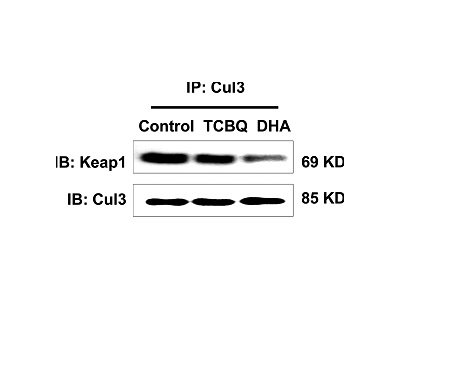
Rabbit Anti-Cullin 3 antibody
CUL 3; Cul-3; CUL3; CUL3_HUMAN; Cullin-3; Cullin3; KIAA0617.
View History [Clear]
Details
Product Name Cullin 3 Chinese Name Cullin3抗体 Alias CUL 3; Cul-3; CUL3; CUL3_HUMAN; Cullin-3; Cullin3; KIAA0617. literatures Research Area Tumour immunology Chromatin and nuclear signals Signal transduction Cyclin Immunogen Species Rabbit Clonality Polyclonal React Species Human, (predicted: Mouse, Rat, Chicken, Dog, Pig, Cow, Horse, Rabbit, ) Applications ELISA=1:5000-10000 IF=1:100-500
not yet tested in other applications.
optimal dilutions/concentrations should be determined by the end user.Theoretical molecular weight 85kDa Cellular localization The nucleus cytoplasmic Form Liquid Concentration 1mg/ml immunogen KLH conjugated synthetic peptide derived from human Cullin 3: 411-510/768 Lsotype IgG Purification affinity purified by Protein A Buffer Solution 0.01M TBS(pH7.4) with 1% BSA, 0.03% Proclin300 and 50% Glycerol. Storage Shipped at 4℃. Store at -20 °C for one year. Avoid repeated freeze/thaw cycles. Attention This product as supplied is intended for research use only, not for use in human, therapeutic or diagnostic applications. PubMed PubMed Product Detail Core component of multiple cullin-RING-based BCR (BTB-CUL3-RBX1) E3 ubiquitin-protein ligase complexes which mediate the ubiquitination and subsequent proteasomal degradation of target proteins. As a scaffold protein may contribute to catalysis through positioning of the substrate and the ubiquitin-conjugating enzyme. The E3 ubiquitin-protein ligase activity of the complex is dependent on the neddylation of the cullin subunit and is inhibited by the association of the deneddylated cullin subunit with TIP120A/CAND1 (By similarity). The functional specificity of the BCR complex depends on the BTB domain-containing protein as the susbstrate recognition component. BCR(SPOP) is involved in ubiquitination of BMI1/PCGF4, H2AFY and DAXX, and probably GLI2 or GLI3. BCR(KLHL9-KLHL13) controls the dynamic behavior of AURKB on mitotic chromosomes and thereby coordinates faithful mitotic progression and completion of cytokinesis. Involved in ubiquitination of cyclin E and of cyclin D1 (in vitro) thus involved in regulation of G1/S transition.
Function:
Core component of multiple cullin-RING-based BCR (BTB-CUL3-RBX1) E3 ubiquitin-protein ligase complexes which mediate the ubiquitination and subsequent proteasomal degradation of target proteins. As a scaffold protein may contribute to catalysis through positioning of the substrate and the ubiquitin-conjugating enzyme. The E3 ubiquitin-protein ligase activity of the complex is dependent on the neddylation of the cullin subunit and is inhibited by the association of the deneddylated cullin subunit with TIP120A/CAND1 (By similarity). The functional specificity of the BCR complex depends on the BTB domain-containing protein as the susbstrate recognition component. BCR(SPOP) is involved in ubiquitination of BMI1/PCGF4, H2AFY and DAXX, and probably GLI2 or GLI3. BCR(KLHL9-KLHL13) controls the dynamic behavior of AURKB on mitotic chromosomes and thereby coordinates faithful mitotic progression and completion of cytokinesis. BCR(KLHL12) is involved in ER-Golgi transport by regulating the size of COPII coats, thereby playing a key role in collagen export, which is required for embryonic stem (ES) cells division: BCR(KLHL12) acts by mediating monoubiquitination of SEC31 (SEC31A or SEC31B). BCR(KLHL3) acts as a regulator of ion transport in the distal nephron; possibly by mediating ubiquitination of SLC12A3/NCC. Involved in ubiquitination of cyclin E and of cyclin D1 (in vitro) thus involved in regulation of G1/S transition.
Subunit:
Forms neddylation-dependent homodimers. Component of multiple BCR (BTB-CUL3-RBX1) E3 ubiquitin-protein ligase complexes formed of CUL3, RBX1 and a variable BTB domain-containing protein acting as both, adapter to cullin and substrate recognition subunit. The BCR complex may be active as a heterodimeric complex, in which NEDD8, covalently attached to one CUL3 molecule, binds to the C-terminus of a second CUL3 molecule. Interacts with RBX1, RNF7, CYCE and TIP120A/CAND1. Part of the BCR(SPOP) containing SPOP. Part of the probable BCR(KLHL9-KLHL13) complex with BTB domain proteins KLHL9 and KLHL13. Part of the BCR(KBTBD10) complex containing KBTBD10. Component of the BCR(KLHL12) E3 ubiquitin ligase complex, at least composed of CUL3 and KLHL12 and RBX1. Component of the BCR(KLHL3) E3 ubiquitin ligase complex, at least composed of CUL3 and KLHL3 and RBX1 (Probable). Part of the BCR(ENC1) complex containing ENC1. Part of a complex consisting of BMI1/PCGF4, CUL3 and SPOP. Part of a complex consisting of H2AFY, CUL3 and SPOP. Interacts with KCTD5, KLHL9, KLHL13, GAN, ZBTB16, KLHL21, KLHL3, KLHL15, KLHL20, C16orf44, GMCL1P1, BTBD1. Part of a complex that contains CUL3, RBX1 and GAN. Interacts (via BTB domain) with KLHL17; the interaction regulates surface GRIK2 expression.
Subcellular Location:
Nucleus. Golgi apparatus.
Tissue Specificity:
Widely expressed. [PTM] Neddylated. Attachment of NEDD8 is required for the E3 ubiquitin-protein ligase activity of the BCR complex. Deneddylated via its interaction with the COP9 signalosome (CSN) complex.
DISEASE:
Defects in CUL3 are the cause of Pseudohypoaldosteronism type 2E (PHA2E) [MIM:614496]. An autosomal dominant disorder characterized by severe hypertension, hyperkalemia, hyperchloremia, hyperchloremic metabolic acidosis, and correction of physiologic abnormalities by thiazide diuretics.
Similarity:
Belongs to the cullin family.
SWISS:
Q13618
Gene ID:
8452
Database links:Entrez Gene: 8452 Human
Entrez Gene: 26554 Mouse
Omim: 603136 Human
SwissProt: Q13618 Human
SwissProt: Q9JLV5 Mouse
Unigene: 372286 Human
Unigene: 12665 Mouse
Unigene: 101949 Rat
Product Picture
References (0)
No References
Bought notes(bought amounts latest0)
No one bought this product
User Comment(Total0User Comment Num)
- No comment



 +86 571 56623320
+86 571 56623320
 +86 18668110335
+86 18668110335

